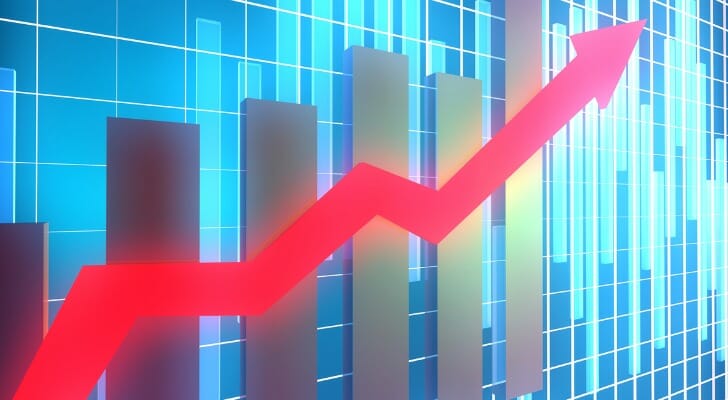By some estimates, nearly one in four Americans is out of work. A steady stream of bankruptcies has begun, both out loud and quietly, and many businesses have shuttered for good. The full extent of the damage wrought by the coronavirus recession will not become apparent until local economies begin to reopen.
But there’s one part of the economy that appears to be going gangbusters: The U.S. stock market, at least as measured by its major indexes. Both the Dow Jones Industrial Average (which tracks shares of the nation’s 30 largest industrial companies) and the S&P 500 have rebounded more than 40% by the second week of June from their mid-March lows. So why is Wall Street recovering even as Main Street continues to struggle?
The Bond Market Is Weak
 Traditionally, when equities fall, investors seek safety in the bond market. These products offer low, but reliable, returns. When the stock market is doing well that low rate of return drives many investors away from bonds. When the stock market tumbles, that reliable rate of return pulls investors right back in.
Traditionally, when equities fall, investors seek safety in the bond market. These products offer low, but reliable, returns. When the stock market is doing well that low rate of return drives many investors away from bonds. When the stock market tumbles, that reliable rate of return pulls investors right back in.
The equity markets began falling in the third week of February as collapsing oil prices and worries about the impact of the pandemic spread. In response the Fed took a number of steps to support the economy, launching lending facilities to ensure that credit flows to businesses and households and buying an unlimited amount of Treasurys. But, crucially for the stock market, the U.S. central bank also slashed interest rates to near zero. By mid-May the 10-year Treasury was only 0.64%, down from 3.23% from its Oct. 1, 2018, level. At such a level bonds don’t even protect investors against inflation.
In addition, investors are concerned that some companies will begin to default on their debt. With major retailers such as J. Crew and Neiman Marcus declaring bankruptcy, events seem to be validating those fears. In other words, equities are getting a lift from weakness in both the government and the corporate bond markets.
Tech Shares Dominate Trading
Consider the outsized influence of Big Tech shares on indexes like the S&P 500. Five such stocks (Amazon, up 29%; Microsoft, up 17%) make up 20% of the S&P 500. The stay-at-home orders that have shuttered many bricks-and-mortar businesses have not had the same impact on tech companies whose employees can work from home. If anything the pandemic made tech companies more important than ever, with increased demand for online communications and video conferencing boosting revenue for corporations providing such services. Further, consumers increasingly are relying on digital forms of entertainment, such as Netflix, instead of going to movie theaters, and for delivery services, such as those provided by GrubHub. These factors have been reflected in these firms’ share prices.
This improvement in shares of Big Tech offsets declines in other sectors, including Big Oil, which overall is down 35% but only comprises 3% of the S&P 500. In other words, this stock market’s gains are narrow, not broad based.
Investors Expect Gains From a Big Recovery
 Several factors have buoyed the investor community’s “animal spirits.” One is the aforementioned intervention by the U.S. central bank. Another is the economy’s rebound. Signs of that rebound were confirmed in early May when the Bureau of Labor Statistics reported that the unemployment rate was 13.3%, a horrendously high figure but vastly less than the 19.8% that Wall Street had been expecting.
Several factors have buoyed the investor community’s “animal spirits.” One is the aforementioned intervention by the U.S. central bank. Another is the economy’s rebound. Signs of that rebound were confirmed in early May when the Bureau of Labor Statistics reported that the unemployment rate was 13.3%, a horrendously high figure but vastly less than the 19.8% that Wall Street had been expecting.
Yet another factor is the unique character of the coronavirus recession. An ordinary recession is what economists call a “cyclical recession.” This means that the recession is brought on by some downturn in the overall business cycle in which overvalued assets lose value, risky lending halts, and inefficient or unproductive businesses close.
The coronavirus recession didn’t begin this way. Entering March 2020 the economy was in generally stable shape. In many ways it had still not recovered from the Great Recession but, if anything prices, value and business activity were too low, not overvalued. The coronavirus recession is something new, call it a crisis or “shock recession.” Before governments ordered a halt to economic activity, businesses and workers were generally productive.
This is why economists believe a “V-shaped recovery” may be possible. While economies have all been halted, the underlying workers, assets and businesses were fundamentally strong before the pandemic. If they can resume activity, it’s possible that those businesses can go right back to making money and paying workers.
A swift recovery depends on strong, effective government action. Some economies, such as Germany, Taiwan and South Korea, have already begun to reopen, and experts generally credit that to comprehensive government action. In the United States, Congress and the Federal Reserve are coordinating their firepower to revive the economy. The $2 trillion CARES Act signaled similarly strong action, and Congress dedicated approximately $500 billion of that bill to large companies likely offer public shares.
Many investors have simply decided that these efforts are more likely to succeed than to fail, helping to stabilize and rebuild the economy in the long run.
The Stock Market Is Not the Economy
Perhaps it shouldn’t come as a surprise that the stock market is going in the opposite direction of the economy at large. In some ways, the divide between the stock market and the economy has been growing for a long time.
In the years since the Great Recession, wage stagnation and deteriorating job quality have dominated the economic news. A nominally booming job market has specialized in creating low-quality work, putting Americans into retail and gig jobs by the double handful. Entrepreneurs have struggled too, with new businesses opening at nearly half the rate they did before the Great Recession.
Over the same 10-year period, though, the stock market climbed from a 2009 low of roughly 6,600 to a recent high just short of 30,000 (as measured by the Dow Jones Industrial Average). Another compelling data point: In the last 25 years, middle-wage incomes have increased by about 6 percent, while over the same time period, the Dow has increased by nearly 600 percent.
In other words, stock prices have belied the underlying economy for years – it’s just more noticeable right now.
The Bottom Line
Major stock indexes have rebounded, as of June’s second week, more than 40% from the lows of late February. Among factors boosting those indexes are a weak bond market, the strength of technology company shares and investor expectations of an economic recovery that stems from Congressional action, Federal Reserve intervention and an unexpectedly – and relatively – low jobless number for May.
Tips for Investing
- The current market recovery may be a great opportunity for investors – or a dangerous trap. A financial advisor can help guide you through these uncharted waters. Finding the right financial advisor who fits your needs doesn’t have to be hard. SmartAsset’s free tool can match you with up to three local financial advisors, and you can choose the one who is best for you. If you’re ready to be connected with local advisors, get started now.
- The coronavirus recession is unlike any other recession which has come before. No government has ever tried to put a modern economy into stasis, nor tried to revive one all at once.
Photo credit: ©iStock.com/Guirong Hao, ©iStock.com/Chunumunu, ©iStock.com/allanswart
